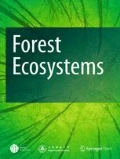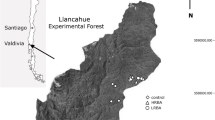Abstract
The short-term effects of selection cutting of different intensities on the forest structure and species diversity of evergreen broad-leaved forest in northern Fujian Province were investigated and analyzed. The results showed that selection cutting of low and medium intensities caused little variation in the forest structure. After cutting, the dominant species retained their leading status in the community. However, the community structure changed significantly following selection cutting of high and extra-high intensities; the status of the dominant species of the community declined dramatically. Some tree species began to disappear from the sampling plots. Except for extra-high intensity cutting, the diversity of tree species did not change significantly for the other three cutting intensities. However, the evenness of the stands was very different among the four kinds of cutting plots. For low and medium intensity selection cutting, the evenness declined slightly. For extra-high intensity selection cutting, the evenness increased to some extent, which might be due to a more even distribution of tree species after cutting. Cutting operations resulted in some adverse reactions to development of arborous species diversity of evergreen broad-leaved forest, particularly serious damage to the forest canopy. But the rational selection cuttings, which may benefit the restoration and maintenance of species diversity over a long period and may come about from the variations in environmental factors such as sunlight, temperature and humidity.
Similar content being viewed by others
References
Forget P, Merona J M, Julliot C. 2001. The effects of forest type, harvesting and stand refinement on early seedling recruitment in a tropical rain forest. J. Trop. Ecol., 17: 593–609
Freckleton R P, Matos D M, Silva B M, Matos D M, Bovi M L A Watkinson A R. 2003. Predicting the impacts of harvesting using structured population models: the importance of density-dependence and timing of harvest for a tropical palm tree. J. Appl. Ecol., 40: 846–858
Fredericksen T S, Ross B D, Hoffman W, Morrison M L, Beyea J, Johnson B N, Lester M B, Ross E. 1999. Short-term understory plant community responses to timber-harvesting intensity on non-industrial private forestlands in Pennsylvania. For. Ecol. Manag., 116: 129–139
Huang Q L, Li Y H. 1991. The current status and countermeasures of natural broadleaved forests in Fujian Province. J. Fujian Coll. For., 11(4): 443–448 (in Chinese with an English abstract)
Huang Q L, Li Y H. 2000. Several problems about sustainable management of natural broadleaved forests in the mid-subtropical zone. J. Fujian Coll. For., 21(1): 1–4 (in Chinese with an English abstract)
Jenkins M A, Parker G R. 1998. Composition and diversity of woody vegetation in silvicultural opening of southern Indiana forests. For. Ecol. Manag., 109: 57–74
Jin Y H, Zhou L, Gu H YY, Dai L M, Shen G R, Liu J. 2003. Dynamic change of arborous species diversity in natural secondary forests after selective cutting on the north slope of Changbai Mountain, Northeast China. J. For. Res., 14(4): 299–302
Jones R H, Stokes S L, Lockaby B G, Stanturf J A. 2000. Vegetation responses to helicopter and ground based logging in blackwater floodplain forests. For. Ecol. Manag., 139: 215–225
Lee C T, Wickneswari R, Mahanib M C, Zakri A H. 2002. Effect of selective logging on the genetic diversity of Scaphium macropodum. Biol. Conserv., 104: 107–118
Ma K P. 1995. Measurement of biotic community diversity. In: Qian Y Q, Ma K P (eds.), Principle and Method of Study on the Biodiversity, Beijing: Science Press. 141–165 (in Chinese)
Rock J H, Beckage B, Gross L J. 2004. Population recovery following differential harvesting of Allium tricoccum Ait. in the southern Appalachians. Biol Conserv., 116: 227–234
Sist P, Nicholas N. 2002. Logging damage and the subsequent dynamics of a dipterocarp forest in East Kalimantan (1990–1996). For. Ecol. Manag., 165: 85–103
Wen Y G, Yuan C A, Li X X, He T P, Lai J Y, Huang M. 1998. Development of species diversity in vegetation restoration process in mid-mountain region of Damingshan, Guangxi. Acta Phytoecol. Sin., 22(1): 33–40 (in Chinese with an English abstract)
Wen Y G. 1996. Effect on the diversity maintenance and restoration of evergreen broadleaved forest by different cutting types. In: Advance of Biodiversity Research. Beijing: Science and Technology Publishing House. 354–360 (in Chinese)
Zhao Z M. 1989. Principle and Method of Community Ecology. Chongqing: Scientific and Technical Documents Publishing House. 81–153
Author information
Authors and Affiliations
Corresponding author
Rights and permissions
About this article
Cite this article
Qiu, Rh., Chen, H. & Zhuo, Lx. Effects of selection cutting on the forest structure and species diversity of evergreen broad-leaved forest in northern Fujian, southern China. For. Stud. China 8, 16–20 (2006). https://doi.org/10.1007/s11632-006-0003-x
Received:
Accepted:
Issue Date:
DOI: https://doi.org/10.1007/s11632-006-0003-x




